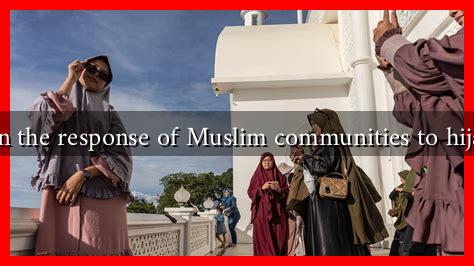-
Table of Contents
What Has Been the Response of Muslim Communities to Hijab Legislation?
The hijab, a traditional headscarf worn by many Muslim women, has become a focal point of debate in various countries, particularly in the context of legislation that seeks to regulate or ban its use. The responses from Muslim communities to such legislation are diverse and multifaceted, reflecting a range of cultural, religious, and political perspectives. This article explores the various reactions from Muslim communities around the world to hijab legislation, highlighting key examples, case studies, and the broader implications of these laws.
The Global Landscape of Hijab Legislation
In recent years, several countries have enacted laws that either restrict or outright ban the wearing of hijabs in public spaces. Notable examples include:
- France: In 2004, France implemented a law prohibiting the wearing of conspicuous religious symbols in public schools, which effectively included the hijab.
- Turkey: The ban on hijabs in public institutions was lifted in 2013, but the debate continues regarding its appropriateness in various settings.
- India: In 2022, the Karnataka High Court upheld a ban on hijabs in educational institutions, igniting widespread protests and discussions about religious freedom.
Community Responses: A Spectrum of Reactions
The responses from Muslim communities to hijab legislation vary significantly based on cultural context, political climate, and individual beliefs. Here are some common themes observed:
- Protests and Activism: Many Muslim women and their allies have taken to the streets to protest against hijab bans. For instance, in India, students organized protests and rallies to assert their right to wear the hijab in educational institutions.
- Legal Challenges: In several instances, Muslim communities have sought legal recourse to challenge hijab legislation. In France, for example, numerous cases have been brought before the European Court of Human Rights regarding the right to wear religious symbols.
- Public Discourse and Education: Some communities have focused on raising awareness about the cultural and religious significance of the hijab. Educational campaigns aim to inform the broader public about the hijab as a personal choice rather than a symbol of oppression.
Case Studies: France and India
Two prominent case studies illustrate the varied responses to hijab legislation:
France: A Divided Society
In France, the 2004 law banning hijabs in public schools sparked significant backlash from Muslim communities. Many viewed the law as an infringement on personal freedoms and religious expression. Organizations such as the Collective Against Islamophobia in France (CCIF) have documented numerous instances of discrimination against Muslim women wearing hijabs. The law has led to a broader discussion about secularism and its implications for religious minorities in France.
India: A Fight for Rights
The hijab controversy in India has highlighted the intersection of religion and politics. Following the Karnataka High Court’s ruling in 2022, protests erupted across the country, with students and activists demanding the right to wear the hijab. The situation has drawn international attention, with various human rights organizations condemning the ruling as discriminatory. The protests have also sparked discussions about the role of women in Islam and their autonomy in choosing how to express their faith.
The Broader Implications of Hijab Legislation
The response of Muslim communities to hijab legislation is not just about the hijab itself; it reflects broader issues of identity, freedom, and the role of religion in public life. Some key implications include:
- Identity and Belonging: For many Muslim women, the hijab is a significant aspect of their identity. Legislation that restricts its use can lead to feelings of alienation and marginalization.
- Political Mobilization: Hijab bans often serve as rallying points for broader political activism within Muslim communities, leading to increased engagement in civil rights issues.
- Interfaith Dialogue: The controversy surrounding hijab legislation has prompted discussions between different religious communities, fostering greater understanding and solidarity.
Conclusion
The response of Muslim communities to hijab legislation is complex and varied, reflecting a rich tapestry of beliefs, values, and cultural contexts. From protests and legal challenges to educational campaigns, these responses highlight the importance of personal choice and religious freedom. As the global conversation around hijab legislation continues, it is crucial to recognize the voices of those directly affected and to foster an environment of understanding and respect for diverse expressions of faith.
For further reading on this topic, you can explore resources from organizations such as Human Rights Watch and Amnesty International.


